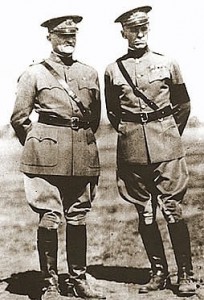There is Something to be Said Here…
 It was 1917. American forces had arrived in France to join the war against Germany, but were not yet actively involved in the fighting. The Commander in Chief of the American forces, General Pershing, made a quick visit to the First Division. General Sibert, the division’s commander, and his chief of staff were absent when the general’s visit was announced, so the chief of operations put together a demonstration of a new method for attacking an enemy trench.
It was 1917. American forces had arrived in France to join the war against Germany, but were not yet actively involved in the fighting. The Commander in Chief of the American forces, General Pershing, made a quick visit to the First Division. General Sibert, the division’s commander, and his chief of staff were absent when the general’s visit was announced, so the chief of operations put together a demonstration of a new method for attacking an enemy trench.
Sibert and his chief of staff arrived in time for the demonstration, and after it was completed Pershing turned to him and asked for his critique. Because of his unfamiliarity with the exercise, he flubbed it, as did the chief of staff when Pershing turned to him. Pershing was disgusted and turned angrily to his staff car to leave.
At that point, the operations chief, a young lieutenant colonel named George Marshall, made a decision. He stepped forward and began explain the situation to the general. Pershing looked at him dismissively and began walking away. Then Marshall surprised everyone by grabbing Pershing’s arm, saying:
“There is something to be said here, and I think that I should say it because I’ve been here the longest.”
Pershing turned and stared at him and snapped, “What have you got to say?”
Marshall then launched into what he called a “torrent of facts” to explain the situation. Pershing did not comment on his facts, but said, “You must appreciate the troubles we have.”
Marshall, figuring he was already in trouble, shot back, “Yes General, but we have them every day, and they have to be solved before night.”
Pershing drove away without saying anything, and Marshall figured his chances of promotion were dead. But Pershing soon brought Marshall onto his staff, and kept him as his aide for the next five years after the war. And, for those of you who are a bit rusty in American history, Marshall later became a five star general and was the Chief of Staff of American forces during WWII.
Of course, none of us would have probably ever heard of him if Pershing had reacted negatively to his impromptu speech, but then we also probably would not have heard of him if he had not spoken up.
This story illustrates what I believe to be the most important asset you possess as a speaker, although you probably would prefer never to need it: the courage to speak up when there is something that needs to be said. It may be to defend your team, or to right a wrong. It may be to call out a superior, or to oppose a misguided majority, or deliver bad news to your most important customer. It’s in times like these that you can make a difference by having the guts to speak out. In times like these, courage can propel you to distinction—or it can get you fired.
Marshall could have kept quiet; no one would have blamed him. Keeping quiet would have been the safest choice, but not the right choice. He spoke out because he had integrity, and because he took responsibility for the situation. If you ask for more responsibility, be prepared to pay the price.
The other point of the story is that there is a difference between courage and recklessness. Marshall would have ruined his career if he had not had a “torrent of facts” at his disposal. If you are going to speak up, keep the emotion out of it—speak reasonably and accurately, and make sure you know what you’re talking about.
Speaking out courageously is risky, of course, but there are some practical benefits. Those who speak out when others won’t, usually get their listeners’ full attention through surprise; they earn tremendous credibility; and they won’t face much competition in getting their voices heard.
Most times in your career you may not need courage to express your views, but if you do anything of importance, there will inevitably be times when you will be put to the test. When there is something to be said here, will you say it?




[…] their minds. This is especially important if you’re challenging those who are more powerful; a torrent of facts can be your best protection and surest way to […]